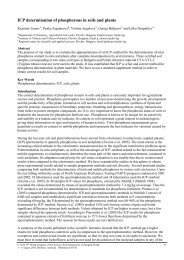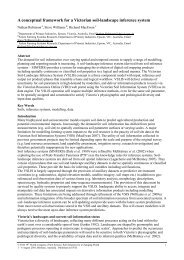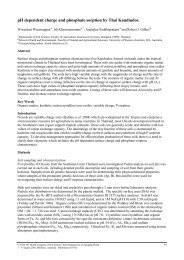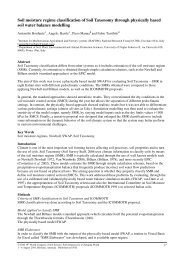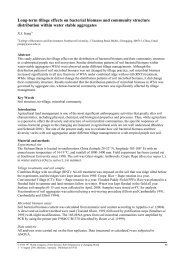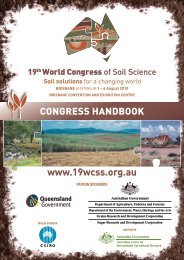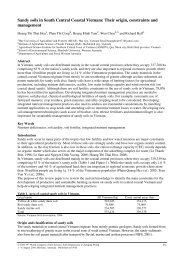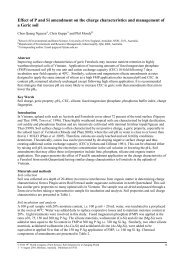Soil art - International Union of Soil Sciences
Soil art - International Union of Soil Sciences
Soil art - International Union of Soil Sciences
You also want an ePaper? Increase the reach of your titles
YUMPU automatically turns print PDFs into web optimized ePapers that Google loves.
<strong>of</strong> the Carnegie Mellon Studio for Creative Inquiry, the Nine Mile Run greenway restoration project in<br />
Pittsburg, Pennsylvania also addresses complex soil remediation processes. On a smaller scale, <strong>art</strong>ist Georg<br />
Dietzler has confronted soil contamination issues by using mycoremediation (i.e., remediation facilitated by<br />
fungi) in his long-term installation projects. In works such as Self-Decomposing Laboratory (1999) and<br />
Moveable Oyster Mushroom Patch (1996-1997), Dietzler makes use <strong>of</strong> the edible oyster mushroom<br />
(Pleurotus ostreatus) to break down organic pollutants such as PCBs (polychlorinated biphenyls). In a<br />
similar bioremediation project, the “Revival Field” (1990 – 1993), <strong>art</strong>ist Mel Chin planted a field <strong>of</strong> heavy<br />
metal absorbing “hypo-accumulators” at the Pig’s Eye Landfill in Minnesota. In his most recent project,<br />
“Paydirt,” Chin launched a public awareness campaign about the high lead content in New Orleans’ soils, a<br />
problem that has increased long after the floodwaters <strong>of</strong> Hurricane Katrina receded.<br />
<strong>Soil</strong> science context: <strong>art</strong> as vehicle<br />
The examples given above are icons <strong>of</strong> eco-<strong>art</strong>. They challenge traditional <strong>art</strong> forms with the development <strong>of</strong><br />
a new visual vocabulary, reclamation aesthetics (Spaid 2002, p. 109; Toland and Wessolek 2010b). As soil<br />
resources become scarcer and scientists look for new approaches to soil protection, eco-<strong>art</strong> and its derivative<br />
soil-<strong>art</strong> might be considered new cultural allies. While relatively more people are involved in the <strong>art</strong>s than<br />
have access to the complicated topics <strong>of</strong> soil science, a combination <strong>of</strong> soil science and <strong>art</strong> could <strong>of</strong>fer soil a<br />
new public image (Wessolek 2002). Art may be seen as a “vehicle” to spark interest and promote a wider<br />
understanding <strong>of</strong> the hidden resource beneath our feet. Artistic involvement, however, need not always result<br />
in a conventional object or exhibition, but can be seen as a creative phase in conservation, education and<br />
public awareness programs. Because cities boast a concentration <strong>of</strong> cultural and <strong>art</strong>istic activity as well as<br />
acclaimed research and academic institutions, urban soils can be considered a natural st<strong>art</strong>ing point for<br />
interdisciplinary collaboration. This is reflected in the selection <strong>of</strong> <strong>art</strong>works above, many <strong>of</strong> which were<br />
created in urban and industrial areas. While the field <strong>of</strong> soil science has traditionally focused on optimizing<br />
soil as a resource for the production <strong>of</strong> food and fuel, city soils have historically been evaluated on different<br />
terms – that is, as medium for buildings and infrastructure. An increase in urban ecological research has led<br />
to new forms <strong>of</strong> perception and environmental protection objectives in cities. For example, urban soils <strong>of</strong>fer<br />
a unique perspective into history. An archive <strong>of</strong> war, peace, cultural, and environmental change is preserved<br />
beneath our backyards and sidewalks. Urban agriculture and on-site rainwater harvesting have also become<br />
important topics for subsistence farmers in developing nations as well as slow-food activists in industrialized<br />
nations. The diversity, dynamics and vulnerability <strong>of</strong> urban soils demand a need for awareness, acceptance<br />
and education and thus provide creative stimulus for <strong>art</strong>istic involvement.<br />
The Dep<strong>art</strong>ment <strong>of</strong> <strong>Soil</strong> Protection at the TU-Berlin has been investigating several approaches to <strong>art</strong>pedology<br />
in recent years. Our own attempts <strong>of</strong> cultivating <strong>art</strong> as a vehicle <strong>of</strong> communication include: a soil<br />
and <strong>art</strong> group that was founded in 2000, the organization <strong>of</strong> several soil-<strong>art</strong> exhibitions, and a permanent<br />
collection <strong>of</strong> soil-<strong>art</strong> on display in the Gorbatschow Building <strong>of</strong> the TU Campus. In 2007 and 2008, we led a<br />
series <strong>of</strong> creative field exercises in an overgrown urban lot near the TU campus. Landscape planning and<br />
environmental engineering students and staff were encouraged to paint their impressions <strong>of</strong> the site with<br />
materials found on or buried in the soil. Since 2002, several thesis papers and three semester-long student<br />
projects have also dealt with the topic <strong>of</strong> soil and <strong>art</strong>. For example, Andreas Vetter created plans for an urban<br />
soil park and Hardy Buhl installed a giant “soil cake” sculpture to demonstrate the remediation <strong>of</strong> a former<br />
wastewater-leaching field. In another example Fritz Kleinschroth and the student project group <strong>Soil</strong> Art on<br />
Urban Brownfields created an oversized “ecological footprint” made <strong>of</strong> onion peels and other kitchen scraps<br />
from a city homeless shelter (Figure 1). The footprint was “stamped” on the “Gleisdreieck,” a former goods<br />
depot in Berlin. A time-lapse video <strong>of</strong> the disappearing footprint was made to illustrate processes <strong>of</strong><br />
humification and mineralization. More student films can be found on youtube under: media, soil, tu-berlin.<br />
Figure 1. “Ecological Footprint” by Fritz Kleinschroth and the student project group “<strong>Soil</strong> Art on Urban<br />
Brownfields.” Time Lapse Documentation <strong>of</strong> 20 m 2 <strong>of</strong> food scraps and carrot peels, Gleisdreieck Berlin, 2007.<br />
© 2010 19 th World Congress <strong>of</strong> <strong>Soil</strong> Science, <strong>Soil</strong> Solutions for a Changing World 10<br />
1 – 6 August 2010, Brisbane, Australia. Published on DVD.



